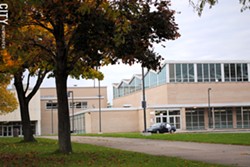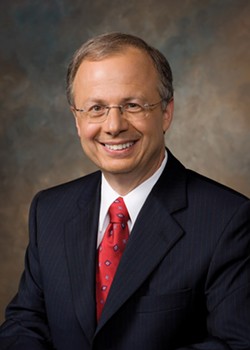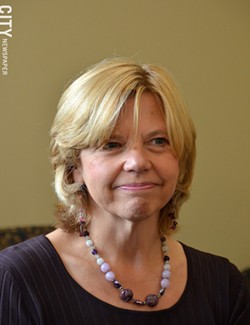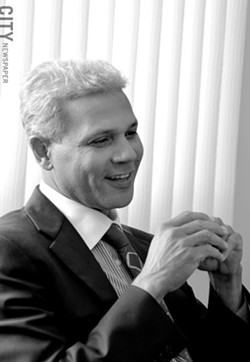[
{
"name": "500x250 Ad",
"insertPoint": "5",
"component": "15667920",
"parentWrapperClass": "",
"requiredCountToDisplay": "1"
}
]
Rochester school district Superintendent Bolgen Vargas rarely talks about increasing the district's graduation rate or raising test scores, the standard promises of most new superintendents.
From his first days in office as interim superintendent, Vargas has instead approached the district's many problems from the outside in: unabashedly declaring that nothing will get fixed if the district has to do it alone.
Unlike his predecessor, Jean-Claude Brizard, who focused his attention on raising expectations for principals and teachers, Vargas has turned to parents, as well as the political and business communities.
Vargas says he wants all of the city's schools to offer a balanced diet of academics, arts, music, and sports — resembling what a suburban school offers parents and students.
But replicating that kind of environment means longer schools days, Vargas says, and more academic support for most students. The challenge for urban school districts like Rochester's is creating middle-class environments without the benefit of additional funding or consistently strong family support. And there is no off-the-shelf model.
At Northeast College Preparatory High School, for example, some teachers have agreed to work flexible schedules to staff the longer hours. And Wegmans vice chair Paul Speranza has tried to build a stable of volunteer tutors to help students at Northeast Prep.
After a recent public meeting, a parent compared the district to a carton of broken eggs.
"Some superintendents have tried to put the eggs back together," she said. "Vargas is trying to make something with the broken eggs."
It's an astute observation. Vargas spends little time talking about the impact of grinding poverty on most city students. Instead, he tends to frame discussions in terms of what city students can do, if they have help.
But that's not to say Vargas isn't trying to fix the district's long dysfunctional systems. He immediately zeroed in on overhauling district attitudes about attendance, arguing that graduation rates will never improve if students are not in school. And he's attacked the district's abysmal recordkeeping practices.
He also launched a campaign aimed at parents promoting the importance of reading among the district's youngest students. Reading proficiency by third grade, like boosting attendance, is a cornerstone of Vargas's approach to improving student achievement.
In both instances, it's to his credit that he's been able to enlist the support of political, business, and community leaders. In this respect, Vargas's roots in the community, which date back to his experience serving on the city school board in the mid 1990's, are evident.
And he's been able to draw on support from a wide range of leaders — from Adam Urbanski, president of the Rochester Teachers Association, and Mayor Tom Richards, to business leaders like Wegmans' Speranza.
Richards, for example, recently pushed some reticent City Council members to approve financial support for the district's clampdown on chronic truants. And Speranza has played a key role in helping Vargas launch one of his signature efforts: expanding school days and lengthening the school year in city schools.
But Vargas has encountered some serious problems, too, and there are indications that more could be brewing. His decision to hire former deputy mayor Patricia Malgieri as his chief of staff shocked many of his strongest supporters. Malgieri had been one of the district's sharpest critics, a point that didn't sit well with many school board members, as well as RTA leader Urbanski.
Vargas's decision to ignore the request of some board members to include input from the NEAD Freedom School in his effort to expand school days was considered by some to be confrontational and subversive. And an argument between Vargas and board members Van White and Mary Adams at a public meeting showed a temperament and decision-making style that still concerns some board members.
And after much fanfare, the tutoring program Wegmans has been trying to create to support Northeast College Prep's expanded hours has not gone smoothly. Training volunteer tutors has progressed slowly, and Vargas recently had to turn to the school board to approve more than $200,000 to pay instructors to do the work that volunteer tutors were supposed to do.
But Vargas vigorously defends Wegmans' efforts. More than 20 volunteers are working with Northeast Prep's students and more are in the pipeline, he says. He adds that 10 paid employees from Hillside Work-Scholarship Connection, a program funded largely by Wegmans, are also providing tutoring services to the school.
Vargas plans to expand the school days at eight more schools next fall. Considering that the district faces a serious budget gap, the plan raises questions about staffing, logistics, and funding. Vargas has enlisted the help of the National Center for Time and Learning, an educational consulting outfit that helps districts realign their resources and staff, to help implement his plans.
In a telephone interview, school board President Malik Evans was dismissive of concerns about funding for Northeast Prep's longer school days. He said he always knew the program would need additional financial support.
In a separate phone interview, board member Willa Powell said she doesn't blame Vargas for unfulfilled commitments of the district's outside partners. But making sweeping changes in how the district functions on such unsure footing does concern her. The board takes the blame for these decisions when they don't work, she said.
"When these superintendents leave, we're left with the debris," she said.
In another example, Vargas recently presented board members with a complete evaluation of all of the district's schools and buildings. Calling it a master plan for the second phase of the city school's modernization plan, Vargas recommended closing five schools. And he called for spending $625 million over the next 10 years remodeling other existing schools.
The board had no input into the plan, Powell said, noting that the massive $1.2 billion construction program evolves with each change in superintendent.
Most board members acknowledge that Vargas has taken the superintendent's job at a time when the State Education Department is pushing major changes through the entire system: new teacher evaluations, a common core curriculum that every school has to at least meet, and fixing priority and focus schools or face intervention from the state. (Priority schools are those the state has identified as persistently low in achievement, and they've received numerous improvement grants with no significant results. Focus schools are those where the state has identified specific student groups, such as English language learners, who are not meeting proficiency standards. Focus schools can become priority schools.)
In a recent interview, Vargas discussed his plans for expanded learning, schools modernization, and neighborhood schools. He strongly defends the efforts at Northeast College Prep and calls the partnership with Wegmans a success.
The following is an edited version of that discussion.
CITY: You've talked about expanding the school day at eight more city schools. Is that still the plan and what's the status?
Vargas: Yes. We had a meeting in November with an organization called the National Center for Time and Learning to assist us with this through a grant with the Ford Foundation. We are in the process of getting the proposal together.
Between now and March 2013, we want to have the people who are going to be involved — the teachers, principals, and central office folks — look at this, including seeing what changes need to be made to the [teachers'] contract to make this work.
We are looking at the school-based living contract, which in this case would mean allowing teachers to have a flexible schedule. We no longer believe that all teachers need to show up at the same time. In the 21th century, if we're going to do expanded learning in an affordable way, we're going to have to call for more flexibility in the system to meet the needs of students.
To make this kind of change in the teachers' contract, don't you need to reach an agreement with about 80 percent of teachers in the impacted schools?
Yes, but we have confidence that we can work collaboratively with the Rochester Teachers Association to do it.
Which schools are you considering for longer days? And how did you select them?
The eight schools are 3, 9, 10, 19, 23, 34, 45, and 46. And maybe Monroe High School.
We wanted to make sure we're working with a mix of schools with an emphasis on priority schools.
But we also wanted to include focus schools: those in danger of getting on the priority schools list because once a school ends up on that list, we have to engage an extraordinary amount of effort to turn that school around. We are taking proactive and preventive measures at the same time we are reacting to the needs of the priority schools.
Schools 3 and 9 are priority schools, and our goal here is to get them off of that list through improved student performance. Schools 10 and 19 are focus schools, and we're trying to make sure they don't get to the point of becoming priority schools.
We have School 23 in there, which is in good standing. But we believe every school can improve.
Northeast College Preparatory has expanded hours, and Wegmans has been trying to support that effort by creating an auxiliary team of volunteer tutors. But they haven't recruited many. Has Wegmans retreated, in part, on their effort?
Actually, they have not. The challenge that we are facing is a need to be flexible in our approach. For example, when people signed up [to volunteer] for tutoring, we had a four-page application that we put them through. Now we've downsized that to just one page front and back.
But that's just a small example of what I mean when I say this isn't a matter of just changing the time schedule. The entire system needs to change in the sense that it has to be more flexible and responsive. And we need to be clear about what kind of support we need to give students and teachers. And what kind of flexibility we need.
I have one answer for people who criticize the tutoring program: last year we had zero volunteers. Now we have some [20]. We have to put things in context.
This district has talked for a very long time about getting outside support, but we don't have the infrastructure in place to respond when people are knocking on our door. We had an application form that was worse than the one we use for applying for a job here. It asks for three references, but we didn't necessarily go back and check those references.
We are learning. But the greater contribution that Wegmans is making is their willingness to work with us. And there are lessons we can learn from them. They are experts in customer service.
Is it necessary for city students to have a tutor? And how important is that to the expanded hours at Northeast Prep?
It is essential for our children because many of them unfortunately don't have a parent who went to college, for example. Having a tutor who can guide you and help prepare you is important.
Here's another example: a lot of the children have said they want more music and art. But you can't just expand the hours and expand the art, sports, music, extracurricular activities, without expanding tutoring and mentoring.
Time and Learning, the company that was here last week, talked about a school in Massachusetts. They surveyed the staff's and students' interests. A number of kids wanted to learn more about karate, and there was a teacher there who knew martial arts. So that teacher started a club at the school.
What I'm trying to say is that we are trying to create a more middle class-like school. But our students need more time and support. I could take you to a school in Mendon or the school where I used to work in Greece. And what you will find are kids getting ready to put on a winter musical, just like they do at School of the Arts.
But at Northeast College Prep, we're not there yet. But if you survey those kids, some of them will tell you that they would love to be engaged in a similar thing. But if you don't have a band or a voice class, how are you going to put on a musical? So you need to look at the entire offering of resources available in each city school. That's what we're engaged in right now, seeing if we can redirect our resources.
You've talked a lot about increasing art, music, and sports in city schools. But some people argue that the focus should be on core academics.
I was at Monroe High School the other day and met a group of kids. They said they were going to lunch. Now as an adult, I'm thinking "9:30 in the morning, and you're going to lunch?"
Then I met a group of adults and I asked, "Isn't it a little early in the school day to be going to lunch?" And they told me, "No, lunch is served at 9:45. The students go home at 1 p.m."
That's the district we have today. Now here I am talking to them about expanding the school day. But you have kids along with parents and the rest of the community who have grown up in this system, and they've gotten used to something that doesn't make sense.
I wish it was as easy as turning a switch and I could say, "Now we are going do things differently." But it's going to have to be a trajectory over time.
What we're trying for our students is what any middle-class school does for its students with art, music, and sports. It's a given. It comes naturally. I've done the research and there's hardly a school in the suburbs throughout the county that doesn't have art and music.
You've said that some of the labor issues involved with expanded hours can be addressed through flexible schedules for teachers.
When this is done correctly, teachers love it because of the [work hours] flexibility. And students love it, too.
Let's say I'm a student and I'm taking an AP [advanced placement] class. I can do it because I have someone to tutor me if I need it. No longer do I have to worry about who is going to help me.
One of the things you will find nationwide is that students are taking more AP courses. But in urban America, the support for students hasn't been there. We've done great in signing kids up for AP courses, but anyone can do that. The question is: are we helping them achieve? And we believe that achievement will come with the support.
It's been reported that a problem with expanded hours at Northeast College Prep is that students aren't staying. You're trying to mobilize support for them, but they're not even there.
That's true. But let's say you're 16 or 17 and you're used to leaving school at a certain time and hanging out. Are we going to change that tomorrow? No, but we believe it can be done.
Students at School 9, which also has extended hours, are staying. And at Northeast College Prep, we believe about 75 percent of the students are staying longer.
You're recommending closing at least five schools. And you're also projecting a budget gap of about $33 million for next year. Do you plan to cut teachers?
We're looking at everything, but we're in the very early stage.
We're looking first at what we need [in terms of teachers] for implementation of the common core curriculum. How much is that going to cost us? And if we want to add art, music, sports, and other types of extracurricular activities, what do we need for that?
The budget gap was projected at $33 million, but that was before the pension increase came up. Teacher retirement costs are increasing by more than 37 percent next year. Potentially our gap could be $44 million.
We were projecting receiving a 3 percent increase from the state, [but] that was before Hurricane Sandy. A lot of resources may have to go down to the New York City region, so state resources may fall as a result. And now we have to be more cautious.
You dipped into the reserve last year, so that's less of an option, right?
Actually, our reserve fund is solid, but the reserve fund is meant for emergency situations. Last year, we used it because we wanted to bring more stability to the district. And we didn't want to put the district through two consecutive years of disruption.
We're looking at all of our resources, including our contracts with outside agencies. One of our highest priorities has been to provide more support for students. But the question is: how are we going to do that? We have to spend our dollars differently.
One way to do that was to look at what we were paying outside providers [for tutoring services] because it was very expensive, and rather ineffective and inefficient. We are now serving more students than ever before through our [inside] tutoring services. I took a lot of heat for that.
But the amount of dollars we used to pay to outside tutoring is a classic example of how, if we establish our priorities, we can better align our resources.
You've just presented a draft proposal to spend roughly $625 million for the second phase of schools modernization. But why do some schools like East High appear in both the first phase of work and now in the proposal for the second phase? Are the funds for the first phase running low?
That's an important question. If you go to East, the work that was first planned was on the outside. But if you go inside, you can see that there is deterioration.
[East is] an enormous undertaking. And when it is finished, it should be [comparable] to a brand new building. We will have invested about $80 million total.
We are also a new team, and we're finding glitches [in the first phase]. By glitches, I mean we want our schools to be air conditioned. If we want to go to a longer school year and summer learning, we have to make some changes. We want to make sure that our schools are modernized so that we can run all these programs at any time of year.
The district has more than 60 schools and buildings. How many will it have in 10 years, based on your proposal?
We will have 46 buildings. And all of them will be up to date and ready to deliver the full range of educational services for children in the 21st century. What we mean by that is they have the technology, the kitchens, and so on.
You get questioned about neighborhood schools in nearly every public meeting. Where is this issue going?
We're using a systemic approach to a very complex problem. We believe we have to start with registration. We have one of the most complex registration systems of any school district.
Right now, if you live in Charlotte or off Lexington Avenue, for example, you may have to take three buses just to get to where the placement center is located to register your kid. That's crazy.
I was talking to a person who lives in Brighton who said you don't even have to show up in person to register your kid. You can call and they take your information over the phone and send you the papers. They make it very easy.
We hope to get to the point where you can go into one of the city's Neighborhood Service Centers near where you live and register your kid.
But the problem is more than that: we have neighborhood schools that aren't really neighborhood schools. It's not just about the buildings, it's about the services and the programs offered in those schools. And implementing the common core curriculum is going to feed into this.
Right now we don't have a common core that goes across the district. We have all kinds of programs and services in different places. If you're a student who wants to be in a musical, how many schools do you have available to you? Maybe School of the Arts can accommodate you, but by the way, you have to audition.
What we have in place now began with Magnet schools, specialized schools. The theory was people from all over will want this school and chose it for its special programs. This is not unique to Rochester; it's typical of urban America. But what we ended up with in most cases was choice without quality.
Right now choice in this district means we ask parents to select seven schools [by preference]. But that's not even a choice. We've been operating this thing in a way that defies common sense.
What percentage of parents uses the bus system to transport their children across town so the children don't have to walk through unsafe neighborhoods to get to school?
We know that a lot of families choose a school that is outside their neighborhood for that reason. We don't know how many, but it's a lot. I hear about it all the time.
But it's not the only reason. Some parents choose for safety. Some choose a school because it's the one they went to. And some chose a school where they used to live, but they've moved. But they don't want to uproot their kid out of that school.
So the issue has a level of complexity.
There's a system problem here, but there's also something paradoxical about it. People say they want a neighborhood school, but they will send their kid somewhere else. And it's not their fault; there are a lot of things in the district that need to be realigned. And that's not going to happen overnight.
How many schools are under populated?
All of them for the most part, except School of the Arts. And School 58 has a waiting list.
When I first came here, people kept telling me that we needed to rent space. I said no, we have too much space now. And I proved that. When we had to move School 16, we moved the school into Freddie Thomas.
Advocates say if you want a good neighborhood, you need a good neighborhood school. They say that choice has diminished neighborhoods by encouraging transiency and instability.
I support a quality school for every neighborhood. Schools ought to be like [public] water. If you drink water in Mississippi, guess what? You're not concerned. If you drink water in New York, it's the same thing. It's not like being in some countries, where it might be safe in one location and dangerous in another.
The vision here is for all of our schools to be middle class-like. When you talk about why parents choose a school, the literature will tell you one thing is undeniable from the East Coast to the West Coast in America: it's the quality of the school that matters most.
For example, Wilson Foundation is located in the same neighborhood as School 2 and School 4. I was on the board when we introduced the International Baccalaureate program at Wilson, and there were 28 families that immediately applied to send their kids to that school on Genesee Street. At the time, it was a fairly challenging street. Families from Penfield and other districts throughout the county were attracted to an internationally recognized curriculum.
A middle-class family out in the county today can look at School X and School Y, and they're about the same. In the district, we can't say that. Last year, School 10 had one day of library services, while School 50 had it five days a week.
So what I'm saying is you can't blame the person for wanting to choose a school that is not in the neighborhood where they live. The decision might be based on safety concerns, but the primary factor, the number-one factor is quality.
City officials are extremely concerned about losing population, particularly middle-class families. What are you doing to try to keep those families?
Oh, they tell me all the time, "If I don't get my kid into one of these three schools, I'm leaving." And I say, "What is it about these three schools?" And they have a very strong argument and I have a very weak argument.
Let me put it in a simpler way. I keep talking about this art thing, but let's say you are living across the street from Monroe, but you want to go to a school that has its own football team, which Monroe doesn't have. What would you do?
It's about opportunity and quality.
I had a person recently ask me how my first year was going. And I told her the good news is that so many of the problems are low-hanging fruit. The bad news is they've caused so many [additional] problems that I lose sleep.
Speaking of...
Latest in News
More by Tim Louis Macaluso
-

RCSD financial crisis builds
Sep 23, 2019 -
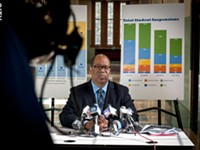
RCSD facing spending concerns
Sep 20, 2019 -

Education forum tomorrow night for downtown residents
Sep 17, 2019 - More »

